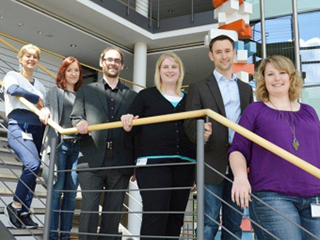Neuropsychopharmacology
The research area neuropsychopharmacology investigates the effects of anti-psychotic, anti-depressant, anti-dementia, and anti-epileptic drugs on the complex central rhythmicity of our central nervous system. The combination of clinico-neurophysiological research and animal experimental investigations allows an understanding of the communication between different areas of the brain in the central processing of information and indicates which "communication difficulties" can occur between these areas as a result of neuropsychiatric illnesses. In this manner, both desired and undesired effects of neuropsychopharmacological agents can be investigated and embedded in new therapeutic concepts.

Head of the Research group
PD Dr. med. Dr. nat. med. Marco Weiergräber
Phone: +49-(0)228-99-307-3196
E-Mail:
marco.weiergraeber@bfarm.de

The Research group
Projects
Mechanisms of antiepileptic action of Bromide: Investigations in a chronid epilepsy
model in vivo and in vitro
Carola Wormuth, Anna Papazoglou, Timo Kirschstein*, Rüdiger Köhling*, Marco Weiergräber
Aims:
The project aims at determining the therapeutic effect of bromide in temporal lobe epilepsy (mTLE) and at a better understanding of its different effects in young versus adult rats. Bromide triggers severe side effects in adults, while these effects are so minimal in children that the substance can be administered as a third-choice antiepileptic in the therapy of generalised tonicoclonic and serious myoclonic attacks. The project is complemented by side effect studies in both age groups, especially a large pharmacokinetic bromide study and behavioural studies of the cognitive effects of long-term administration of bromide.
Methods:
Implantable radiofrequency transmitters are used to measure EEG recordings both superficially (motor cortex) and deeply (hippocampus). Besides, a pilocarpine epilepsy model is developed and optimised in young rats.
Outcome:
The pilocarpine model can be successfully applied in young rats; EEG recordings display epileptic attack activities. Variations in the bromide concentration in animals treated with varying doses can be detected by ion chromatography.
Conclusions:
Based on the pilocarpine model it is now possible to carry out the bromide experiments in young and adult rats.
*Oscar-Langendorff Institut für Physiologie, Universität Rostock, Rostock
Characterisation of thalamocortical and hippocampal neuronal circuits in various
mouse models - use of radiotelemetry
Magdalena. Siwek, R. Müller*, Christina Henseler, Anna Papazoglou, Marco Weiergräber
Aims:
The functional role of calcium channels (Cav2.3 & Cav3.2) shall be described as to thetagenesis and sleep regulation. Thetaoscillations stimulated pharmacologically by urethane and pilocarpine are characterised concerning different vigilance stages. Thetaoscillations are correlates for cognitive processes, so that conclusions can be drawn as to a healthy or a pathological brain function.
Methods:
Use of implantable radiotelemetry, admitting of superficial cortical and deep hippocampal EEG recordings in test animals in combination with injections of urethane and pilocarpine.
Outcome:
Longer sleep and a changed sleep architecture are found in Cav2.3-knockout-mice compared with control animals. Pharmacological stimulation by urethane causes a significant increase in the slow-wave sleep.
Conclusions:
Cav2.3-channels modulate the oscillatory activity of the hippocampal neurons and the thalamocortical regulatory circuits during sleep.
*Klinik und Poliklinik für Psychiatrie und Psychotherapie, Köln
Mechanisms of central auditory processing and alterations in cases of schizophrenia
- impact of phsychotropic pharmaceuticals on auditory information processing
Andreas Lundt, Anna Papazoglou, Ralf Müller*, Marco Weiergräber
Aims:
Corticothalamic circuits protect the consciousness from being flooded with information, a process that is in multiple disorder in patients with schizophrenia [1]. Oscillatory processes shall be investigated in detail during auditory information processing; understanding is sought of the interaction between linked neuronal subsystems. Of special interest are the voltage-controlled calcium channels (Cav2.3 & Cav3.2) and the neuronal networking effects of selective psychopharmaceuticals. The newly gained information shall support clinical assessment, diagnostics, and the choice of medication.
Methods:
Auditory Brainstem Recordings (ABRs) are complemented by radiotelemetry systems to obtain EEG recordings using deep electrodes. These tests are combined with acoustic stimulation and administration of neuroleptics.
Outcome:
First ABR results show that the auditory performance of Cav2.3-knockout-mice is similar to that of the C57BL/6J control animals.
Conclusions. Unlike Cav1.3-knockout-mice, Cav2.3-knockouts are not deaf. This suggests a functional specialisation of the Cav2.3-channel in the mouse organ of Corti.
References:
- Behrendt RP (2006) Dysregulation of thalamic sensory “transmission“ in schizophrenia: neurochemical vulnerability to hallucinations. J Psychopharmacol 20(3):356–372
- Waka N, Knipper M, Engel J (2003) Localization of the calcium channel subunits Cav1.2 (alpha1C) and Cav2.3 (alpha1E) in the mouse organ of Corti. Histol Histopathol 18(4):1115–1123
* Klinik und Poliklinik für Psychiatrie und Psychotherapie, Köln
